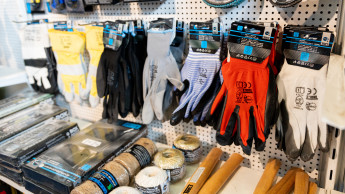
deep insights, facts & figures
08.11.2013
The retail expert Neil Munz-Jones on the strategies, mistakes and opportunities that home improvement retailers encounter on their way to becoming omni-channel businesses. Full version of the interview published in DIY International 4/2013
What is your first advice you give to a big box retailer who wants to transform his business into an Omni-Channel business? Have a plan that recognizes your own market circumstances and brand strength and size, even if the plan is an active decision to wait (a ‘lag’ rather than ‘lead’ strategy) for your market to become more Omni-Channel before you make large-scale investments; as a minimum ensure: • The plan influences all your new store decisions (such as the size and purpose of any future stores) and IT investments (aim to get a ‘single view’ of the customer regardless of channel) • You take a challenging approach to all new store acquisitions, lease renewals and revamps. The role of the store is likely to change significantly and the fixed costs associated with stores could become a drag on overall profitability if more of your business moves to direct delivery via internet orders • You understand the economics of shifting your business to more Omni-Channel (e.g. the split of costs between fixed and variable will change as well as the additional costs of Omni-Channel services such as Click & Collect) • Plan for a more integrated business...it’s not just another channel that you bolt on separately • Plan for a more ‘social’ world: think carefully about (and invest in) social media strategies for your business. Reputations are made (& lost) on Twitter, Facebook and other social media forums What are the biggest mistakes made by retailers who want to become an Omni-Channel player? There are a number of mistakes that are quite understandable and also fairly common: • Setting up the internet channel as a separate channel to the stores channel so the 2 parts of the business have a tendency to ‘compete’ with each other; Omni-Channel retailers measure and reward sales across channels e.g. they allocate internet sales to the nearest store so that store-staff are happy to provide great advice and service even if they know the customer wants to purchase online • Underestimating the threat from the internet because its adoption in the DIY retail sector has been slow so far. Watch out for the twin threat from the likes of Amazon (big, cross-category retailer, growing fast in DIY) and the small, nimble and low-cost pure-play specialists (such as taps.co.uk, wallpaperdirect.co.uk, betterbathrooms.com). If nothing else the internet will put pressure on your prices even if the timing of this will vary by country • Underestimating the importance of online as a shop window - with customers showing an increasing tendency to research products online before visiting a store, it's vital that the retailer's website supports customers in deciding what products are right for them. This can be as simple as buying guides and informative product content, through to inspirational planning tools (e.g. Homebase's 'Create The Look') Why are the home improvement retailers so late in finding successful online strategies compared to other retail industries? • Despite its many benefits, the internet has been a ‘disruptive’ influence that has caused many retailers to go out of business or at least face reduced profitability (the obvious examples are the books, music and electronics retail sectors). • The specific characteristics of the DIY market (such as bulky, low margin, slow-selling products, the need for advice for many projects) and the limited technology (before broadband) and supply-chain capabilities (limited Home Delivery) ensured that the DIY retail sector was a ‘follower’ rather than a ‘leader’ in eCommerce developments; unlike Amazon in books and music, there were no good examples of successful online-only Home Improvement retailers in the early years of eCommerce • In this context it has not really been in the interests of established retailers to embrace actively the internet unless they have to; for example the UK Omni-Channel market is more developed than the market in France; as a result B&Q’s Omni-Channel strategy is more developed (even if still in its early days) than that of Castorama • So it has been less a question of finding successful online strategies and more a question of delaying the development of online strategies until it becomes necessary • What is interesting now is that, while the market characteristics remain the same, the improved technology and supply chain capabilities are opening up opportunities to embrace Omni-Channel more than in the past. So retailers may not have the choice for much longer…note Amazon’s big push into the DIY retail sector. What role is omni-channel retailing playing in relatively young home improvement markets such as Eastern Europe, South America or Asia? • As our report title suggests the market has evolved from eCommerce (the ability to transact over the internet) to Multi-Channel (the ability to transact over multiple channels but not necessarily across more than one channel in a single transaction) to Omni-Channel (the ability to transact across multiple channels in a single transaction); it is possible that the younger home improvement markets may be able to jump straight to Omni-Channel by learning (and avoiding) the limitations of the multi-channel approach (a bit like in the telecoms market where some emerging markets have moved straight to mobile phones and so avoided the need to invest in the infrastructure of ‘landline’ phones) • Lessons can be learnt from the more developed markets; for example had B&Q known in 2000 what it knows now about the impact of Omni-Channel on store sizes it is unlikely it would have embarked on such a major investment in Big Box stores as it did between 2000 and 2004; even if it had built the number of stores, they are unlikely to have been as large (note Kingfisher’s last announcement that 18 stores have been/are being downsized via sub-letting space to other retailers and that it thinks B&Q has 20% too much space). This understanding should influence the thinking of Big Box retailers in younger markets about the number and size of any future stores • The rise of smartphones and tablets is a global phenomenon even if penetration rates are different. Leveraging this trend should create great opportunities for retailers in all markets to engage with their consumers and offer them an enhanced customer experience Will the established retailers such as B&Q, Obi, Leroy Merlin or Home Depot survive in an Omni-Channel world? It depends on how they respond! • While they have no divine right to survive (many of your readers will remember past market leaders such as Hechingers in the USA or Texas Homecare in the UK…and now Praktiker in Germany), they have very strong assets such as brands, stores, financial resources so they are in a good place to succeed if they adopt the right approach • The best retailers are realising that omni-channel offers new opportunities to stretch their offer. They can bring product innovation to customers more quickly, and offer extended range in a way that would simply not be economic in a stocked store environment (e.g. Home Depot now selling over 500,000 lines online vs a typical 35,000 in its stores) • As mentioned before the DIY retail market has characteristics (lots of slow-selling and/or bulky sku’s and the need for advice) that suggest this will always be a market where stores have a key role to play, so long as retailers adapt their stores to the changing consumer needs that have resulted from the growth in Omni-Channel • Each retailer needs to adapt its own strategy but this is likely to include a store portfolio with a combination of some or all of the following: fewer, smaller, more convenient for picking up goods, more of a Showroom with greater interaction with customers • What is also likely to differ is the pace of adoption in each country; for example ‘click and collect’ is now an expected service in the UK and so has become hard for UK DIY retailers not to offer it, even though from an economic profitability perspective it may not be what they’d ideally like to do
Related articles
Read also

 Menü
Menü















